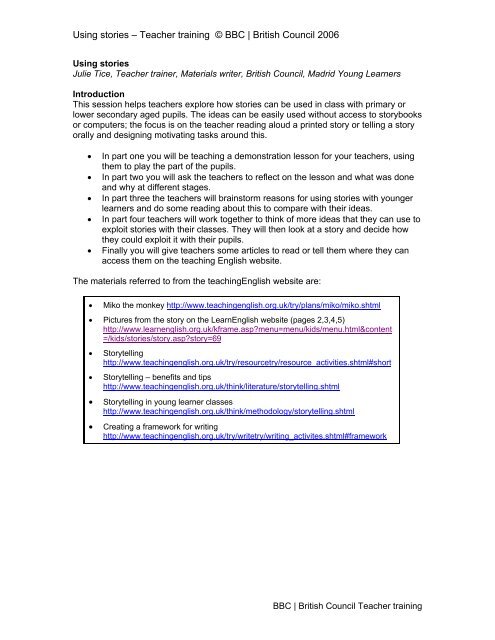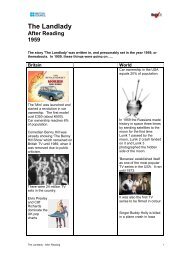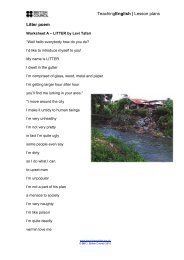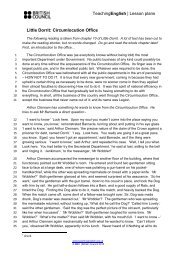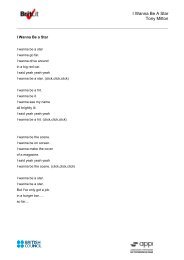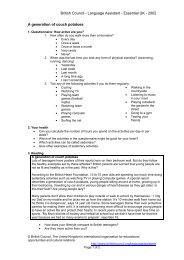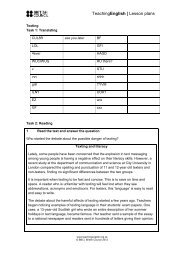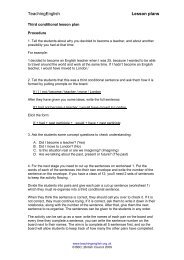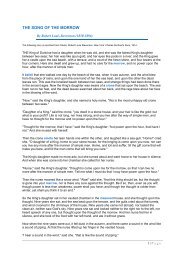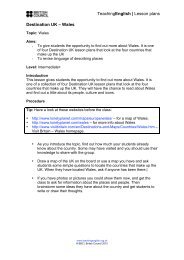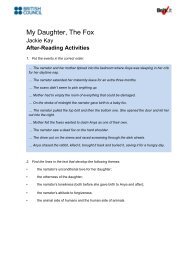Using stories – Teacher training © BBC - TeachingEnglish
Using stories – Teacher training © BBC - TeachingEnglish
Using stories – Teacher training © BBC - TeachingEnglish
You also want an ePaper? Increase the reach of your titles
YUMPU automatically turns print PDFs into web optimized ePapers that Google loves.
<strong>Using</strong> <strong>stories</strong> <strong>–</strong> <strong>Teacher</strong> <strong>training</strong> <strong>©</strong> <strong>BBC</strong> | British Council 2006<br />
<strong>Using</strong> <strong>stories</strong><br />
Julie Tice, <strong>Teacher</strong> trainer, Materials writer, British Council, Madrid Young Learners<br />
Introduction<br />
This session helps teachers explore how <strong>stories</strong> can be used in class with primary or<br />
lower secondary aged pupils. The ideas can be easily used without access to storybooks<br />
or computers; the focus is on the teacher reading aloud a printed story or telling a story<br />
orally and designing motivating tasks around this.<br />
• In part one you will be teaching a demonstration lesson for your teachers, using<br />
them to play the part of the pupils.<br />
• In part two you will ask the teachers to reflect on the lesson and what was done<br />
and why at different stages.<br />
• In part three the teachers will brainstorm reasons for using <strong>stories</strong> with younger<br />
learners and do some reading about this to compare with their ideas.<br />
• In part four teachers will work together to think of more ideas that they can use to<br />
exploit <strong>stories</strong> with their classes. They will then look at a story and decide how<br />
they could exploit it with their pupils.<br />
• Finally you will give teachers some articles to read or tell them where they can<br />
access them on the teaching English website.<br />
The materials referred to from the teachingEnglish website are:<br />
• Miko the monkey http://www.teachingenglish.org.uk/try/plans/miko/miko.shtml<br />
• Pictures from the story on the LearnEnglish website (pages 2,3,4,5)<br />
http://www.learnenglish.org.uk/kframe.asp?menu=menu/kids/menu.html&content<br />
=/kids/<strong>stories</strong>/story.asp?story=69<br />
• Storytelling<br />
http://www.teachingenglish.org.uk/try/resourcetry/resource_activities.shtml#short<br />
• Storytelling <strong>–</strong> benefits and tips<br />
http://www.teachingenglish.org.uk/think/literature/storytelling.shtml<br />
• Storytelling in young learner classes<br />
http://www.teachingenglish.org.uk/think/methodology/storytelling.shtml<br />
• Creating a framework for writing<br />
http://www.teachingenglish.org.uk/try/writetry/writing_activites.shtml#framework<br />
<strong>BBC</strong> | British Council <strong>Teacher</strong> <strong>training</strong>
<strong>Using</strong> <strong>stories</strong> <strong>–</strong> <strong>Teacher</strong> <strong>training</strong> <strong>©</strong> <strong>BBC</strong> | British Council 2006<br />
Trainer’s notes<br />
Part one: The demonstration lesson<br />
Stage 1. Write the session objectives on the board or display them on an OHT.<br />
Objectives<br />
• To provide you with some practical ideas on how to exploit <strong>stories</strong> in the classroom<br />
• To consider the benefits of using <strong>stories</strong> in the language classroom<br />
Explain that the session will begin with a demonstration lesson, followed by a discussion<br />
and then group work to generate further ideas about how <strong>stories</strong> can be used in class.<br />
Tip: <strong>Using</strong> trainees to act as pupils in demonstration lessons helps them to experience<br />
a lesson from the learner’s point of view. It is an excellent way of showing how teaching<br />
ideas work in practice. You can ask all of the teachers to act as pupils or just some of<br />
them with the rest watching and taking notes. Alternatively, if you have the opportunity,<br />
you could demonstrate the lesson to the teachers with real pupils, or show them a<br />
video of a class.<br />
Stage 2. Tell the teachers that for the purposes of the demonstration lesson they are a<br />
class of nine, ten or eleven year old elementary level pupils.<br />
Write on the board _ _ _ _ _ _ and play hangman to get the teachers to guess the word<br />
monkey. Stick up a picture of monkeys in the middle of the board and then elicit from<br />
them what they know about monkeys. Prompt them as necessary. Write up their ideas in<br />
short sentences around the picture. For example:<br />
• They are funny.<br />
• They are like people.<br />
• They are noisy.<br />
• They swing from trees.<br />
• They eat bananas.<br />
• They live in the jungle.<br />
• Etc.<br />
Stage 3. Now show the teachers Worksheet A from Miko the monkey<br />
http://www.teachingenglish.org.uk/try/plans/miko/miko.shtml<br />
Tell them they have to read the sentences about monkeys and decide if they think they<br />
are true or false. Give out the worksheets and tell them they can work in pairs.<br />
As they are working, go round and stick short texts about monkeys around the room.<br />
The loudest animal on Earth is the blue whale. It is also the largest animal on Earth.<br />
The second loudest animal is the Howler Monkey which lives in South American<br />
rainforests.<br />
<strong>BBC</strong> | British Council <strong>Teacher</strong> <strong>training</strong>
<strong>Using</strong> <strong>stories</strong> <strong>–</strong> <strong>Teacher</strong> <strong>training</strong> <strong>©</strong> <strong>BBC</strong> | British Council 2006<br />
The Mandrill is a large, noisy, and ferocious monkey that lives in Western Africa. The<br />
mandrill is the biggest monkey and the most colourful mammal. It is closely related to<br />
the baboon. It is primarily terrestrial (it lives on the ground) but it sleeps in trees. The<br />
mandrill walks on all four legs. They live in troops of up to 50 mandrills and they walk<br />
up to ten kilometres each day. These intelligent primates are endangered due to loss of<br />
habitat.<br />
Habitat:<br />
Monkeys live in forests, grasslands, high plains, and mountain habitats. Many monkeys<br />
are arboreal (they spend most of their lives in trees); others like baboons and<br />
macaques live mostly on the ground.<br />
Diet:<br />
Monkeys eat leaves, fruit, seeds, nuts, grass, roots, eggs, insects, spiders and small<br />
mammals.<br />
Monkeys are primates, an order of intelligent mammals that also includes apes and<br />
people. There are about 125 species of monkeys. A group of monkeys is called a troop.<br />
The loudest monkey is the Howler Monkey. The most acrobatic is the Spider Monkey.<br />
Anatomy:<br />
Adult monkeys range from about 0.6 to 1.2 metres long. Most also have a long tail <strong>–</strong> up<br />
to almost 0-9 metre long. They weigh from 113g (the pygmy marmoset) to 45kg (the<br />
mandrill). Monkeys have long arms, and five fingers on their hands and five toes on<br />
each foot.<br />
Barbary ape<br />
A monkey, not an ape. The only non-human primate to live in Europe. Barbary apes<br />
have yellow-grey to grey-brown fur. Their under-parts are paler, and their faces are<br />
dark. They do not have a tail. Native to northwestern Africa, introduced to Gibraltar.<br />
Latin name: macaca sylvana.<br />
The pygmy marmoset is the smallest living monkey in the world. It is only 35cm long,<br />
including the tail, and weighs about 80-100g. It lives in the tropical rain forests of South<br />
America. It has a tawny coat sprinkled with grey and its tail is ringed.<br />
<strong>BBC</strong> | British Council <strong>Teacher</strong> <strong>training</strong>
<strong>Using</strong> <strong>stories</strong> <strong>–</strong> <strong>Teacher</strong> <strong>training</strong> <strong>©</strong> <strong>BBC</strong> | British Council 2006<br />
Monkeys are divided into two groups, Old World monkeys (from Africa, Asia and<br />
Europe) and New World monkeys (from the Americas).<br />
New World monkeys<br />
• live in south and central America<br />
• are usually smaller<br />
• live in trees<br />
Old World monkeys<br />
• live in Africa, Asia and Europe<br />
• are larger<br />
• live in trees or on the ground<br />
• The information above was adapted from information on<br />
http://www.enchantedlearning.com/coloring/m3.shtml and<br />
http://www.bbc.co.uk/nature/wildfacts/factfiles/218.shtml<br />
When the teachers have decided on their answers, elicit from them their ideas. There<br />
will probably be some disagreement - don’t tell them if their answers are right or wrong<br />
yet.<br />
Then tell them to stand up and move around the room and look at the texts on the wall.<br />
They contain the answers to these questions so they can check their answers.<br />
When they have done this, tell them to sit down again and go through the answers.<br />
Stage 4. Tell the teachers that shortly they are going to listen to a story about a monkey.<br />
It’s a story about a little monkey who has seven sisters and brothers. Display the four<br />
pictures from the story on the board, but not in the correct order. Ask the teachers to<br />
look at the pictures and in groups of three or four make up a story based on them. They<br />
should do this orally <strong>–</strong> they don’t need to write it down.<br />
When they are ready, ask them to tell their <strong>stories</strong> to the group.<br />
Stage 5. Ask the teachers to listen to the story called Miko the Monkey and see if it is<br />
similar or different to the <strong>stories</strong> they made up themselves.<br />
Read the story to the teachers, using eye contact, facial expression, gestures and your<br />
voice to express drama, sadness etc. (See Performance skills in Storytelling - benefits<br />
and tips Paula Stoyle)<br />
http://www.teachingenglish.org.uk/think/literature/storytelling.shtml<br />
After you have read it, ask them what was similar to or different from their own <strong>stories</strong>.<br />
Ask them which order the pictures should be in and ask one of them to come up and<br />
rearrange them on the board.<br />
Stage 6. Hand out copies of the text to the teachers. Read the story aloud again,<br />
pausing every so often for them to fill in words.<br />
<strong>BBC</strong> | British Council <strong>Teacher</strong> <strong>training</strong>
<strong>Using</strong> <strong>stories</strong> <strong>–</strong> <strong>Teacher</strong> <strong>training</strong> <strong>©</strong> <strong>BBC</strong> | British Council 2006<br />
Tip: Tell the teachers that with a real class of pupils you would encourage them to ask<br />
questions about any parts they didn’t understand, encouraging pupil to pupil<br />
explanation. You could then ask the pupils to read through it again in groups or pairs<br />
but since they are teachers you are not going to do that.<br />
Stage 7. Now tell them to turn over their copies of the text. You are going to read out<br />
some statements about the story, which may be true or false. If they are true the<br />
teachers should stand up; if they are false they should stay sitting. Read out the<br />
statements from Worksheet C.<br />
Now tell the teachers to look again at the story and in pairs to make up two or three<br />
more true or false statements about the story.<br />
They then read out their statements and the other teachers stand up or stay sitting as<br />
appropriate.<br />
Stage 8. Tell the teachers that with a real class you may continue with some further<br />
activities. For example:<br />
• Pupils complete gapped summary of story (Worksheet D) and wordsearch<br />
(worksheet E) from Miko the Monkey.<br />
http://www.teachingenglish.org.uk/try/plans/miko/miko.shtml<br />
• Pupils act out the story in groups. One is the narrator (a student good at reading)<br />
Others act the parts of the different monkeys. Add more dialogue.<br />
• Pupils prepare a storyboard of the story. (i.e. they draw pictures to illustrate the main<br />
events of the story and write a summary of the story underneath each picture)<br />
Ask the teachers if they enjoyed the lesson. Now they are going to be back in their role<br />
as teachers.<br />
Part two: Reflection on the demonstration lesson<br />
Stage 9. Elicit from teachers what age / level they think the lesson they did was<br />
appropriate for.<br />
Possible answer: This particular story and process would probably be most suitable<br />
for children of 9 <strong>–</strong> 10 years old who already have an elementary level of English.<br />
Point out that <strong>stories</strong> can however be used with younger children and with children with<br />
less English. Why? Because the story itself engages the children, they don’t worry about<br />
not understanding everything (young children are used to this in their daily lives!) Also it<br />
is easy to adapt the tasks we use to the age and language level of the children.<br />
Also point out that you can use <strong>stories</strong> that are designed for slightly younger children<br />
successfully with older EFL learners too.<br />
Invite comments from teachers who have already used <strong>stories</strong> with their classes.<br />
Stage 10. Ask the teachers to think back to the demonstration lesson and elicit from<br />
them the different stages and aims of the different activities. Either give them a partially<br />
<strong>BBC</strong> | British Council <strong>Teacher</strong> <strong>training</strong>
<strong>Using</strong> <strong>stories</strong> <strong>–</strong> <strong>Teacher</strong> <strong>training</strong> <strong>©</strong> <strong>BBC</strong> | British Council 2006<br />
completed grid for this or elicit from them the stages and aims and slowly reveal the<br />
completed grid on OHT. Then give them a copy of this to keep.<br />
Example lesson plan<br />
Pre story-telling<br />
activities<br />
While story-telling<br />
activities<br />
After story-telling<br />
activities<br />
Activity Aim<br />
Hangman To establish topic of the lesson in a<br />
fun way, to get pupils’ attention<br />
Brainstorming ideas To draw on pupils’ general<br />
about monkeys knowledge, to create interest, to set<br />
the scene, to revise or feed in some<br />
useful language on the topic<br />
True/false facts about To draw on and increase pupils’<br />
monkeys - prediction knowledge of the natural world (cross<br />
and wall crawl reading curricular links), to encourage reading<br />
activity<br />
for specific information in semi<br />
authentic texts, to allow movement in<br />
the classroom<br />
Story prediction from To encourage creativity, to encourage<br />
pictures<br />
co-operation, to provide opportunity<br />
for oral fluency practice, to establish<br />
some vocabulary or phrases that may<br />
come up in the story, to provide<br />
motivation to listen to the story<br />
Listening to and joining To provide practice in understanding<br />
in with reading the story a whole story (extended discourse),<br />
to focus pupils on meaning and<br />
understanding, to engage them fully,<br />
to encourage awareness of<br />
sound/spelling relationships, to<br />
encourage memorisation of chunks of<br />
language.<br />
True false questions To check that pupils have understood<br />
the story, to enable them to use some<br />
of the language from the story, to<br />
encourage them to think about the<br />
story, to provide opportunity for fun<br />
and movement.<br />
Gapfill and wordsearch To recycle some of the key language<br />
items from the story.<br />
Acting out the story or To encourage spoken or written<br />
preparing a storyboard fluency, to encourage dramatic<br />
expression, to encourage<br />
interpretation of the story through<br />
drawing and retelling, to provide<br />
further practice of key language, to<br />
encourage memorisation of language<br />
chunks.<br />
<strong>BBC</strong> | British Council <strong>Teacher</strong> <strong>training</strong>
<strong>Using</strong> <strong>stories</strong> <strong>–</strong> <strong>Teacher</strong> <strong>training</strong> <strong>©</strong> <strong>BBC</strong> | British Council 2006<br />
Part three: Discussion and reading <strong>–</strong> why use <strong>stories</strong>?<br />
Stage 11. Ask the teachers to brainstorm in groups what the advantages are in using<br />
<strong>stories</strong> in the classroom with younger learners.<br />
Tip: Getting teachers to think about a topic and discuss their ideas before they read is<br />
good for several reasons. As well as tuning them into thinking about the topic and<br />
letting them relate what they already know to new ideas, it caters for teachers with<br />
different levels of experience or knowledge about the area. If they have a lot of ideas<br />
the brainstorming stage will go on longer; if they have fewer ideas you can introduce<br />
the reading sooner.<br />
Hand out or display:<br />
• The first part of Storytelling<br />
http://www.teachingenglish.org.uk/try/resourcetry/resource_activities.shtml#short<br />
• The first part of Storytelling benefits and tips<br />
http://www.teachingenglish.org.uk/think/literature/storytelling.shtml<br />
• The first part of Storytelling in young learner classes<br />
http://www.teachingenglish.org.uk/think/methodology/storytelling.shtml<br />
Give the teachers time to read through these.<br />
Alternatively you could divide the teachers into three groups and give them just one of<br />
the texts to read: group A reads text one, group B reads text two and group C reads text<br />
three Then regroup them (into groups of ABC, ABC, ABC etc) and let them compare<br />
what they have read.<br />
Tip: Giving different groups just one out of several texts to read is a technique called<br />
jigsaw reading. It is useful in <strong>training</strong> when you don’t want the teachers to spend a lot<br />
of time reading in the session but more time on exchanging ideas orally. Make sure that<br />
you organise the regrouping stage very clearly so that the teachers know who to go and<br />
talk with.<br />
Stories can be a very versatile and powerful teaching tool<br />
Stories are fun and motivational<br />
Stories allow students to be creative and imaginative<br />
Stories give students a sense of achievement<br />
Story telling gives students a chance to practice oral fluency and extended<br />
discourse<br />
Stories introduce language in a comprehensible and meaningful way<br />
Stories are authentic<br />
Listening to <strong>stories</strong> can develop important skills such as prediction, guessing,<br />
hypothesising, and message decoding<br />
Story telling can provide valuable cultural input<br />
If the students know the story in their L1 they can use this knowledge to help them<br />
understand or tell the story in their L2<br />
There are lots of different fun activities that spin off from <strong>stories</strong><br />
(from Storytelling Fiona Lawrie)<br />
http://www.teachingenglish.org.uk/try/resourcetry/resource_activities.shtml#short<br />
<strong>BBC</strong> | British Council <strong>Teacher</strong> <strong>training</strong>
<strong>Using</strong> <strong>stories</strong> <strong>–</strong> <strong>Teacher</strong> <strong>training</strong> <strong>©</strong> <strong>BBC</strong> | British Council 2006<br />
What can storytelling offer?<br />
Children have an innate love of <strong>stories</strong>. Stories create magic and a sense of wonder at<br />
the world. Stories teach us about life, about ourselves and about others. Storytelling is a<br />
unique way for pupils to develop an understanding, respect and appreciation for other<br />
cultures, and can promote a positive attitude to people from different lands, races and<br />
religions.<br />
Storytelling and intercultural understanding<br />
There are a number a number of ways in which storytelling can enhance intercultural<br />
understanding and communication. Stories can…<br />
allow children to explore their own cultural roots<br />
allow children to experience diverse cultures<br />
enable children to empathise with unfamiliar people/places/situations<br />
offer insights into different traditions and values<br />
help children understand how wisdom is common to all peoples/all cultures<br />
offer insights into universal life experiences<br />
help children consider new ideas<br />
reveal differences and commonalties of cultures around the world<br />
Other benefits of using storytelling in the classroom.<br />
Stories…<br />
Promote a feeling of well being and relaxation<br />
Increase children's willingness to communicate thoughts and feelings<br />
Encourage active participation<br />
Increase verbal proficiency<br />
Encourage use of imagination and creativity<br />
Encourage cooperation between pupils<br />
Enhance listening skills<br />
Commonalities of cultures around the world<br />
Stories reveal universal truths about the world. Through <strong>stories</strong> we see how very<br />
different people share the same life experiences and how human nature can transcend<br />
culture.<br />
(from Storytelling <strong>–</strong> benefits and tips Paula Stoyle)<br />
http://www.teachingenglish.org.uk/think/literature/storytelling.shtml<br />
<strong>BBC</strong> | British Council <strong>Teacher</strong> <strong>training</strong>
<strong>Using</strong> <strong>stories</strong> <strong>–</strong> <strong>Teacher</strong> <strong>training</strong> <strong>©</strong> <strong>BBC</strong> | British Council 2006<br />
According to David Vale and Anne Feunten in 'Teaching children English: A <strong>training</strong><br />
course for teachers of English to children', kids start developing their identity as readers<br />
and listeners from the age of three or four years old, because they start constructing<br />
their world of meaning and imagination when they are first exposed to different <strong>stories</strong> of<br />
life. It is vitally important that we, as teachers, support this development.<br />
Constructive and creative comprehension<br />
Storytelling is a kind of reading which requires children to be active participants in the<br />
construction of meaning. Children get fully involved while listening to a story and they<br />
also feel joy and satisfaction. As language teachers, we are always tempted to regard<br />
the teaching of reading and listening only as a variety of comprehension activity but in<br />
doing so we sometimes discourage children from becoming "good" readers of English.<br />
<strong>Using</strong> storytelling in class, children develop a constructive and creative comprehension.<br />
What constructive and creative comprehension implies<br />
When children listen to a story, in terms of comprehension response, they get involved in<br />
different types of mental processes. First, they create a mental picture of what they are<br />
listening to. Then, they can imagine what is going to happen next. Children also identify<br />
themselves with the characters and situations in the story relating them to their own<br />
experiences. Last but not least, children apply their own values to those found in the<br />
story. Therefore, each child's response will be unique because it will demonstrate<br />
individual interpretation, it will relate to the whole story and it can be also discussed and<br />
shared with others in the class.<br />
From Storytelling in young learner classes Patricia Lelmini<br />
http://www.teachingenglish.org.uk/think/methodology/storytelling.shtml<br />
Ask the teachers if they can add any further points from their earlier discussion.<br />
Part four: Ideas exchange<br />
Stage 12. Ask the teachers to think about other activities that could be used with<br />
children at the pre story- telling, while story-telling and after story-telling stages.<br />
Depending on the age groups and levels that the teachers are working with, you may<br />
want to get them thinking about different classes.<br />
Then give them a copy of the worksheets below and ask them to compare their ideas:<br />
<strong>BBC</strong> | British Council <strong>Teacher</strong> <strong>training</strong>
<strong>Using</strong> <strong>stories</strong> <strong>–</strong> <strong>Teacher</strong> <strong>training</strong> <strong>©</strong> <strong>BBC</strong> | British Council 2006<br />
Younger (5,6,7 years old) / lower level/ non reading writing<br />
Pre- storytelling Use pictures to illustrate key vocabulary or events in the story, ask<br />
questions<br />
Pre-teach key vocabulary orally<br />
Use real objects to teach key vocabulary<br />
Give a brief summary of the story in L1 first<br />
Personalise<br />
Chant, rhyme or song connected with the theme<br />
Show them cardboard figures of characters/ places in the story and talk<br />
about these<br />
While storytelling <strong>Teacher</strong><br />
Dramatic voice<br />
Point to pictures<br />
Mime and gesture<br />
Use sound effects<br />
Stopping and asking questions (encouraging prediction, asking opinions)<br />
Pupils<br />
Listen<br />
Sequence pictures<br />
Holds up pictures (of objects/characters/scenes)<br />
Joining in with story<br />
Do gestures<br />
After storytelling Draw a picture of your favourite scene<br />
Make masks or finger puppets and act out the story<br />
Story chant (a simplified version of the story in a chant form)<br />
Make a book of the story<br />
Make a class book of the story (each child makes one page)<br />
Elementary level (8,9 years old)<br />
Pre- storytelling Show pictures connected to the story and ask questions about them<br />
Give words or phrases from the story and children guess what it is about<br />
Give children a picture from the story and children suggest words or<br />
phrases associated with it<br />
Personalise<br />
Chant, rhyme or song connected with the theme<br />
Pre-teach key vocabulary orally<br />
While storytelling <strong>Teacher</strong><br />
Dramatic voice<br />
Point to pictures<br />
Mime and gesture<br />
Use sound effects<br />
Stopping and asking questions (encouraging prediction, asking opinions)<br />
Pupils<br />
Listen<br />
Sequence pictures<br />
Holds up pictures (of objects/characters/scenes)<br />
Joining in with story<br />
Do gestures<br />
Hold up words<br />
After storytelling Order events (simplified from the story)<br />
Draw pictures for each part of the story<br />
(storyboard with simplified text)<br />
Act out the story<br />
Retell the story making mistakes <strong>–</strong> children have to correct you<br />
<strong>BBC</strong> | British Council <strong>Teacher</strong> <strong>training</strong>
<strong>Using</strong> <strong>stories</strong> <strong>–</strong> <strong>Teacher</strong> <strong>training</strong> <strong>©</strong> <strong>BBC</strong> | British Council 2006<br />
Older/higher level (10,11 years old)<br />
Pre- storytelling Give some excerpts from the story (e.g. on handout) <strong>–</strong> children predict<br />
what it’s about<br />
Quiz about the topic<br />
Give children a picture from the story and children write phrases or<br />
questions about it<br />
Give title and children predict words they think will be in the story<br />
Give children questions about the story and they answer them<br />
Give children a gapped summary of the story<br />
While storytelling <strong>Teacher</strong><br />
Dramatic voice<br />
Mime and gesture<br />
Use sound effects<br />
Ask questions for further information (details)<br />
Ask for a personal response - What would you do?<br />
Pupils<br />
Join in reading story<br />
Read in groups<br />
Hold up words<br />
Listen and sequence sentences<br />
After storytelling Children make up own questions about the story<br />
Order events<br />
Draw and write a storyboard<br />
Retell the story making mistakes <strong>–</strong> children have to correct you<br />
Complete a worksheet about the story <strong>–</strong> characters, settings, events,<br />
favourite scene etc<br />
Dictation and dictation of questions for pupils to add detail. See Creating a<br />
framework for writing Jeff Fowler<br />
http://www.teachingenglish.org.uk/try/writetry/writing_activites.shtml#frame<br />
work<br />
Children make changes to the story (e.g. different ending)<br />
Children make up their own story<br />
Stage 13. Organise the teachers into groups or four or five and give each group a<br />
different story to read through. Ask them to think of what activities they could use as prestory,<br />
while story, after story.<br />
Then regroup the teachers and get them to exchange their ideas.<br />
You can download further <strong>stories</strong> from the LearnEnglish website<br />
http://www.britishcouncil.org/kids-<strong>stories</strong> or you could use <strong>stories</strong> from other sources<br />
such as your course book or well-known <strong>stories</strong> typed up. Encourage the teachers to<br />
make an action plan <strong>–</strong> to use one of these or another story with one of their classes.<br />
Tip: It is an important part of a <strong>training</strong> session to include a stage where teachers are<br />
encouraged to plan how they can incorporate some aspect of what has been discussed<br />
into their own teaching. In a follow up <strong>training</strong> session you can ask them to tell each<br />
other about how their lessons went.<br />
Stage 14. Give teachers a copy of the following articles to read or tell them to read them<br />
on the website to consolidate what you have covered in this session.<br />
• Storytelling Fiona Lawtie<br />
http://www.teachingenglish.org.uk/try/resourcetry/resource_activities.shtml#short<br />
• Storytelling <strong>–</strong> benefits and tips Paula Stoyle<br />
http://www.teachingenglish.org.uk/think/literature/storytelling.shtml<br />
• Storytelling in young learner classes Patricia Lelmini<br />
http://www.teachingenglish.org.uk/think/methodology/storytelling.shtml<br />
<strong>BBC</strong> | British Council <strong>Teacher</strong> <strong>training</strong>


